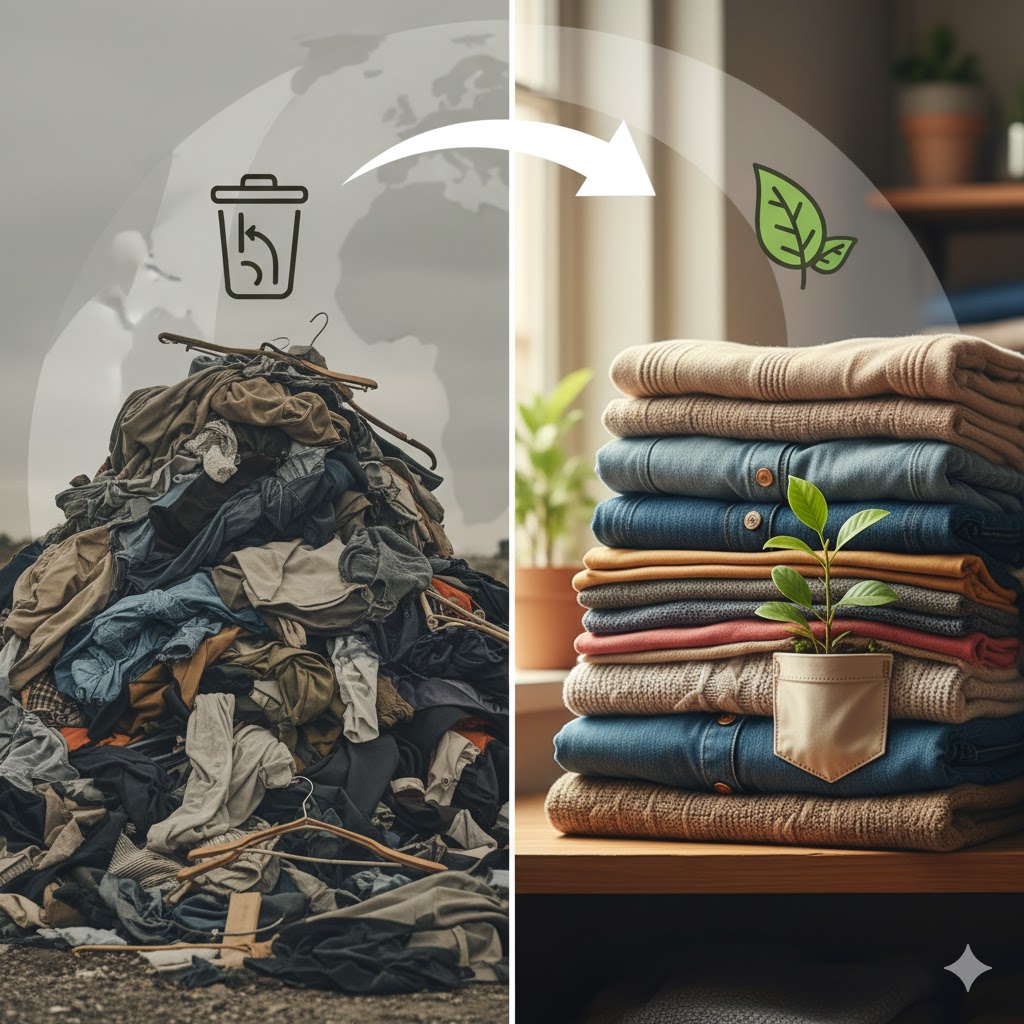Fast fashion drives waste, while thrift shopping offers a way to reduce it. Each year, Americans throw out over 13 million tons of clothing, much of it synthetic and non-biodegradable. Fast fashion’s rapid production and disposable culture fuel this crisis, contributing to 10% of global carbon emissions and 92 million tons of textile waste annually. In contrast, thrift shopping extends the life of clothing, cuts down on resource-heavy production, and keeps items out of landfills.
Key Points:
- Fast fashion promotes cheap, short-lived clothing, leading to overproduction and waste.
- Producing a single pair of jeans can use 1,800 gallons of water.
- Thrift shopping reduces waste, supports reuse, and aligns with growing consumer interest in reducing environmental harm.
- Challenges include poor-quality donations and unsellable items often ending up in landfills.
Quick Comparison:
| Aspect | Fast Fashion | Thrift Shopping |
|---|---|---|
| Waste Generation | 92 million tons/year | Reduces waste by reusing clothing |
| Resource Use | High (e.g., 1,800 gallons for one pair of jeans) | Minimal (no new production needed) |
| Material Lifespan | Short (synthetics take centuries to decompose) | Extends life of garments |
| Environmental Impact | High (pollution, microplastics, carbon emissions) | Low (reuses existing items, less resource use) |
| Community Benefits | None | Supports local initiatives like City Thrift |
Thrift shopping may not solve the entire problem, but it’s a practical step toward reducing waste and conserving resources. By choosing secondhand clothing, you help curb fast fashion’s harmful effects while supporting local communities.
Fast Fashion’s Impact on the Environment
Fast fashion’s environmental toll spans every stage of its lifecycle – from sourcing raw materials to the mountains of waste it leaves behind. This industry is a major contributor to global pollution, with production processes being particularly harmful due to excessive resource use and chemical contamination.
Production Waste and Resource Use
The waste generated by fast fashion starts long before clothes hit the racks. Processes like dyeing and finishing are responsible for 36% of the industry’s global pollution footprint. These stages release toxic chemicals into waterways, harming ecosystems and endangering nearby communities.
Consider this: producing just one cotton shirt requires up to 700 gallons of water. Meanwhile, synthetic fibers rely on energy-heavy processes fueled by fossil fuels. Globally, the fashion industry ranks as the second-largest consumer of water, competing with vital needs like agriculture and drinking water.
Adding to the problem, chemical runoff from dyeing operations damages local ecosystems. Fabric scraps from cutting and sewing are often discarded rather than recycled, further contributing to waste. The industry’s rapid production cycle only worsens these issues – Zara can churn out new designs in two weeks, while Shein does it in just 10 days.
Short Product Lifespans and Landfill Impact
Fast fashion garments are designed for quick turnover, with many items worn just a handful of times before being thrown away. This disposable mindset has created an overwhelming waste crisis.
An estimated 85% of all textiles end up in landfills. Synthetic fabrics make matters worse, as they can take centuries to decompose. The relentless cycle of fleeting trends encourages consumers to buy and discard clothing at an unsustainable pace, putting immense strain on waste management systems.
Microplastic Pollution from Synthetic Materials
Synthetic fabrics are a hidden source of pollution, releasing microplastics during regular use. Each time synthetic clothing is washed, tiny plastic fibers break free and flow into the water system. Around 500,000 tons of microfibers enter the ocean annually – equivalent to 50 billion plastic bottles. These microplastics contaminate marine environments, where they are mistaken for food by aquatic life and eventually make their way into the human food chain.
Materials like polyester, nylon, and acrylic are the biggest culprits behind this pollution. Today, nearly 70% of clothing worldwide is made with synthetic fibers, a number that keeps growing as brands prioritize cost over sustainability. Current wastewater treatment systems are not equipped to filter out these microscopic particles, allowing them to pollute rivers, lakes, and oceans.
On top of microplastics, the fashion industry generates 300 million tons of plastic and consumes 1.3 billion barrels of oil annually, accounting for a fifth of global pollution. With textile manufacturing emissions expected to rise by 60% by 2030, as noted by the UN Framework Convention on Climate Change, the need for change in how clothing is produced and consumed has never been more urgent.
How Thrift Shopping Reduces Waste
Fast fashion creates mountains of textile waste, but thrift shopping offers a meaningful way to counteract this issue. By giving clothes a second life, it reduces the need for new production, conserves resources, and even bolsters local community programs. This simple shift not only saves materials but also builds stronger, more connected communities.
Extending the Life of Clothing
When you buy second-hand clothing, you’re keeping garments out of landfills and extending their usefulness. Many textiles, especially those made from synthetic materials, can take centuries to decompose. Every thrifted item represents one less piece of clothing destined for a landfill and one less new item that needs to be manufactured. It’s a small but impactful way to cut down on waste while making the most of what’s already been created.
Conserving Resources
Thrift shopping plays a big role in conserving energy and water by sidestepping the resource-heavy processes involved in making new clothes. A study by ThredUp found that opting for used clothing instead of new reduces your carbon footprint by a whopping 82%. Take jeans, for example – producing just one pair can use about 1,800 gallons of water. By choosing pre-owned jeans, you eliminate the need for that water-intensive production. Since new clothing production contributes roughly 10% of global carbon emissions, largely due to synthetic fibers made from petroleum (which make up nearly 70% of clothing), buying second-hand directly reduces the strain on water, energy, and raw materials.
Strengthening Communities and Promoting Sustainability
Thrift stores often go beyond environmental benefits by supporting local community initiatives. Take City Thrift in Kansas City, for example. This non-profit reinvests its proceeds into programs that help individuals struggling with homelessness and poverty. As City Thrift explains:
“By shopping at City Thrift, you can make a difference in your closet and your local community. All proceeds from our thrift stores in Kansas City and the surrounding communities are kept local and benefit City Union Mission.”
This dual-purpose approach – reducing waste while uplifting communities – resonates strongly, especially with younger generations who are increasingly drawn to sustainable and ethical shopping practices.
Challenges with Thrift Shopping
Thrift shopping grapples with the overwhelming clothing waste generated by fast fashion. Thrift stores face mounting hurdles as they try to manage the sheer volume of discarded garments flooding their donation streams.
Quality Issues with Donated Clothing
One of the biggest challenges is the poor quality of many fast fashion items being donated. A lot of these garments are already heavily worn, damaged, or made with materials that don’t hold up over time. This means they quickly lose their shape or usability, making them unsellable. The influx of these low-quality donations reduces the availability of durable, desirable items on thrift store shelves, which can turn potential buyers away. As a result, these donations often contribute to growing piles of unsellable inventory.
What Happens to Unsold Donations
Even beyond quality concerns, not every donation ends up on store racks. Many items are rejected outright due to damage, excessive wear, or simply because there’s no demand for them. Unfortunately, a large portion of these unsellable donations ends up in landfills or is shipped overseas. When exported, these items can overwhelm local waste systems and disrupt textile markets in other countries.
The numbers paint a grim picture: less than half of used clothing is collected for reuse or recycling. In the European Union, for example, 87% of used garments are either incinerated or sent to landfills, and only about 1% is recycled into new clothing. This stark reality underscores the limitations of current textile recycling technologies.
Even organizations like City Thrift in Kansas City, which meticulously sorts donations and prioritizes reuse while supporting community initiatives, face significant challenges in managing the overflow of unsellable items.
The scale of the problem becomes even clearer when considering global consumption habits. Each year, consumers buy around 80 billion new pieces of clothing – a staggering 400% increase compared to 20 years ago. This relentless demand overwhelms donation systems and highlights the limits of secondhand retail in addressing fast fashion’s waste problem. While thrift shopping plays a helpful role, it simply can’t absorb the environmental toll of fast fashion on its own.
Smart Shopping Tips to Reduce Waste
You don’t need to completely change your lifestyle to make smarter fashion choices. By tweaking how you shop and donate, you can cut down on waste while still enjoying high-quality clothing.
Choosing Quality Over Quantity
Opt for durable pieces that stand the test of time instead of chasing short-lived trends. When shopping secondhand, look for natural fabrics like cotton, wool, and linen. These materials not only feel great but also break down more easily in the environment compared to synthetic fabrics, which can linger in landfills for decades.
Before buying anything – whether it’s new or thrifted – take a moment to check its quality. Look over seams for loose threads, test zippers and buttons, and ensure there aren’t signs of excessive wear. To avoid impulse buys, create a shopping list based on what’s missing in your wardrobe. This approach helps you focus on filling actual needs rather than grabbing trendy or cheap items that might not last. By prioritizing quality, you’re contributing to a circular economy that keeps clothing in use longer and reduces textile waste.
Donating Items the Right Way
When donating clothes, make sure they’re in good condition. Only give away clean, gently used pieces that you’d feel comfortable handing to a friend. Items that are heavily worn, stained, or damaged usually don’t make it to thrift store shelves and often end up as waste.
For clothing that’s too worn out to donate, check for local textile recycling programs. Many communities now accept old clothing to repurpose into things like insulation, cleaning materials, or other useful products.
If you’re donating quality items, consider mission-driven thrift stores. For instance, City Thrift in Kansas City makes the process easy with drop-off hours from 9 AM to 9 PM. Plus, your donations support meaningful community initiatives.
Shopping at Mission-Driven Thrift Stores
Where you shop matters just as much as what you buy. Mission-driven thrift stores like City Thrift show how secondhand shopping can tackle both environmental and social issues.
At City Thrift, all proceeds stay local, supporting City Union Mission. This organization helps people experiencing homelessness by providing resources and opportunities to improve their lives. So, that $15 sweater you picked up? It’s not just saving resources – it’s helping someone in your community.
“By shopping at City Thrift, you can make a difference in your closet and your local community.” – City Thrift
“Let your old stuff…do good stuff!” – City Thrift
This kind of shopping makes every purchase more impactful. Instead of supporting generic retail chains, you’re backing a business model that prioritizes community well-being over profit. Your money stays local, funding programs that address real needs while reducing waste and lowering demand for new production.
Mission-driven thrift stores often go a step further by partnering with recycling programs to handle unsold items responsibly. In Kansas City, City Thrift operates multiple locations where you can find unique treasures, knowing your purchase supports both sustainability and community development.
Making Better Fashion Choices
Opting for thrift shopping over fast fashion plays a big role in cutting waste and lowering carbon emissions. Sure, fast fashion might seem convenient and easy on the wallet upfront, but thrift shopping offers a more environmentally friendly option that also supports your local community. The environmental impact of our clothing choices makes it worth reconsidering how we shop.
When you choose secondhand clothing, you extend the life of garments, keeping them out of landfills and reducing the demand for new production. For perspective, it takes about 2,700 liters of water to produce a single cotton shirt – that’s enough drinking water for one person for two and a half years.
While thrift shopping can come with challenges like limited selection or varying quality, focusing on natural fabrics and taking the time to inspect items can lead to great finds. Plus, many thrift stores partner with textile recycling programs, ensuring even unsold donations are repurposed instead of wasted.
These choices go beyond just environmental benefits – they directly impact local communities. For example, shopping at mission-driven stores like City Thrift in Kansas City helps fund City Union Mission’s programs for people experiencing homelessness. It’s a way to connect, reducing waste with meaningful community support.
With fast fashion sales expected to nearly double to $291.1 billion by 2032, there’s an opportunity to change the narrative. Supporting local thrift stores, donating thoughtfully, and shopping at stores with a purpose can create a ripple effect. These small steps help conserve resources, reduce waste, and strengthen the communities around us.
Making better fashion choices isn’t about perfection – it’s about progress. Every thrifted item and intentional decision brings us closer to a future where fashion works in harmony with both people and the planet.
FAQs
How does thrift shopping help reduce waste and support sustainability?
Thrift shopping is a smart way to cut down on waste while breathing new life into pre-loved items. Instead of ending up in landfills, these goods find new homes, reducing the strain on our planet. Plus, it helps curb the demand for producing new items, a process that often eats up natural resources and adds to pollution.
When you buy second-hand clothing, furniture, or household goods, you’re actively participating in a circular economy – a system that prioritizes reusing materials instead of throwing them away. This approach saves resources and lowers greenhouse gas emissions linked to production and waste management. On top of that, shopping at thrift stores like City Thrift supports local communities and charitable initiatives, making it a choice that’s both environmentally and socially impactful.
What challenges do thrift stores face in managing donations of fast fashion items?
Thrift stores often struggle with the overwhelming influx of fast fashion donations. These items are generally made from lower-quality materials, which means they tend to wear out or get damaged faster. As a result, many of them don’t meet the standards needed for resale, making it tougher for thrift stores to find them a second home.
On top of that, the sheer volume of fast fashion donations puts a strain on storage and sorting resources. Staff and volunteers spend a significant amount of time sifting through items to decide what can be sold, what can be recycled, and what needs to be responsibly discarded. By donating thoughtfully and ensuring your items are in good condition, you can make a real difference. This helps thrift stores like City Thrift stay focused on reducing waste and promoting sustainability while continuing their mission to serve the community.
Why does choosing fewer, high-quality clothes matter for the environment?
Choosing a smaller wardrobe with well-made clothing not only cuts down on waste but also encourages a more mindful way of living. When you invest in durable, long-lasting pieces, you reduce the need for frequent replacements, which helps limit textile waste and saves valuable resources.
Shopping second-hand, at stores like City Thrift, is another smart choice. It gives clothing a second life, keeping it out of landfills, and allows you to discover one-of-a-kind items. On top of that, it supports local initiatives aimed at tackling homelessness and poverty, making it a win for both you and your community.





